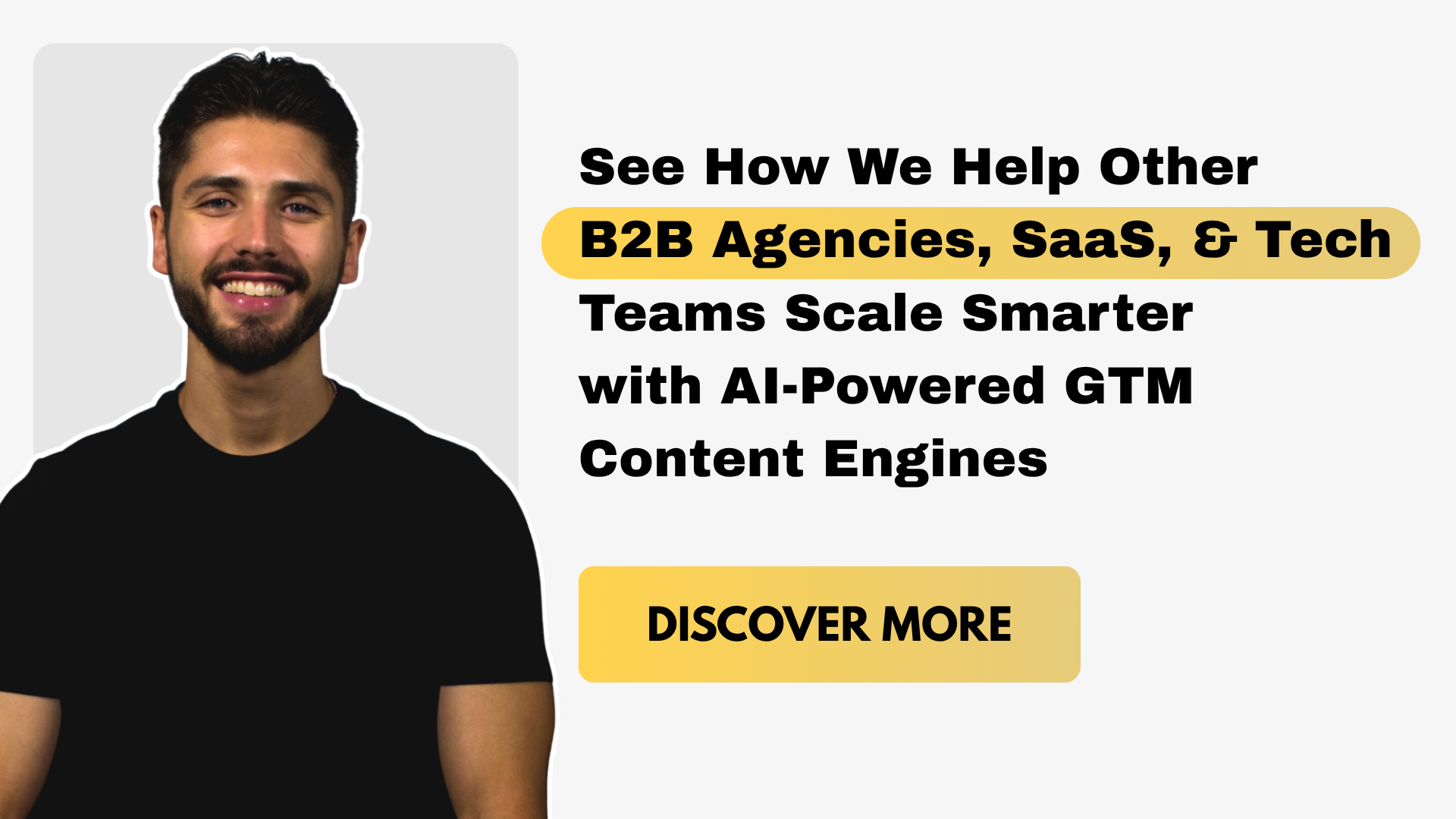How Content Marketing Drives Sales in B2B SaaS
Key Takeaways
Why most SaaS content fails to convert—and how to build a system that supports pipeline, not just pageviews.
The strategic role of content within your GTM engine and how it drives conversion across the entire buyer journey.
A tactical, buyer-led content marketing framework tailored for B2B SaaS teams scaling in competitive categories.
Real-world examples of SaaS companies using content to reduce churn, speed up deals, and differentiate.
How Hyve’s GTM Content Engine turns your raw ideas into omnichannel content that actually closes.
Table of contents
Why Content Is the Unsung Hero of SaaS Sales
The Shift from SEO to Sales Enablement
What Makes a Winning SaaS Content Marketing Strategy?
Types of Content That Actually Drive SaaS Sales
A Framework for B2B SaaS Content Marketing Strategy
SaaS Content Marketing Examples That Actually Convert
How Hyve Turns Content Into a Sales System
Conclusion: Content Is Your Most Scalable Sales Rep
FAQs
Why Content Is the Unsung Hero of SaaS Sales
There’s a quiet truth in B2B SaaS that rarely makes it to your board decks or weekly stand-ups: most teams are sitting on a goldmine of expertise that never sees the light of day.
The product is solving real problems. The customer success stories are there. The founders have a point of view that could shape the category. But without the right content strategy, all of that stays locked behind NDAs, internal meetings, and Slack threads.
When content is treated as a side project—or worse, a monthly checkbox for SEO—the sales team loses its most powerful non-human asset. In modern SaaS, content isn't just top-of-funnel fluff. It's your silent seller.
The asset that educates before the first call. The rep that never sleeps. The trust-builder that nudges a lead from “vaguely interested” to “ready to close.”
If your content isn’t showing up in the moments where buyers are researching, hesitating, or evaluating, you’re essentially invisible. And invisible doesn’t win deals.
The Shift from SEO to Sales Enablement
Let’s be clear: SEO still matters—but ranking #1 for a keyword means nothing if that traffic doesn’t convert, influence buying decisions, or support pipeline progression.
Traditional content teams often obsess over traffic and vanity metrics. But traffic without intent or alignment is just noise. The shift for SaaS companies today is moving from isolated keyword-based publishing to an integrated sales enablement model.
In this model, your content is not just optimized for algorithms—it’s optimized for buyer context. Instead of chasing pageviews, you’re building strategic assets that handle objections, differentiate your approach, and guide the buyer through your solution logic. It’s content that reduces friction, both before and after the demo.
Think of it this way: your sales process isn’t just human. It’s content-led. Every touchpoint, from an SDR’s first outreach to a founder’s LinkedIn post, to the onboarding video in your help center, is shaping the narrative. The question is—are you controlling that narrative, or letting competitors define it?
What Makes a Winning SaaS Content Marketing Strategy?
The best SaaS content strategies don’t live in isolation. They sit at the center of the GTM engine. They’re tightly aligned with sales motions, product roadmap, and customer feedback loops.
A winning content strategy doesn’t just ask, “What should we publish?” It asks, “What conversations do we need to own?”
First, it begins with buyer intimacy. Understanding the psychological and practical roadblocks your audience faces is non-negotiable. Content needs to anticipate these friction points and address them before your AE ever gets on the call.
Second, you must reverse-engineer your content from the metrics that matter: SQLs, close rates, onboarding velocity—not just impressions or shares. Content isn’t a branding tool alone; it’s a revenue engine.
Finally, velocity matters. Not in the sense of pushing out daily fluff, but in building a repeatable, scalable system where your best ideas, founder insights, customer learnings, and sales objections are turned into media assets—at speed and without bottleneck.
Watch this video where I break down the exact B2B content marketing strategy I’d use if I started from 0.
Types of Content That Actually Drive SaaS Sales
A list of formats means nothing without strategy. But once your goals are clear, here’s what high-performing content often looks like:
Use Case Deep Dives: Not generic case studies. These are role-specific, outcome-led narratives that show exactly how your product solves problems in real-world scenarios. For example, how enablement leads use your platform to reduce ramp time—not just vague ROI.
Strategic Comparisons: Pages and videos that directly address how your product stacks up against alternatives. Not just "why we're better," but “when we’re a better fit”—and why. It helps buyers self-qualify faster.
Founder POV Content: SaaS buyers are risk-averse. If you’re a challenger brand, your founder’s insights can shift the perception of credibility. Whether via videos, essays, or podcast interviews, this kind of content builds trust and shows vision.
Objection-Handling Content: For every deal that stalls, there’s a question your buyer didn’t get answered. Build content that answers those questions proactively—before they become deal blockers.
Customer Expansion Stories: If you're selling to large teams or upselling into new departments, show how other customers did it. Expansion-focused content is a growth multiplier that’s often overlooked.
Each piece of content should map to an actual moment in the buyer journey, from initial curiosity to final procurement approval.
A Framework for B2B SaaS Content Marketing Strategy
To build a system that scales, you need more than ideas—you need infrastructure. Here’s a simplified version of the GTM-aligned framework we use at Hyve:
1. Buyer Journey Mapping: Every ICP persona mapped across awareness, consideration, decision, and post-sale phases. This ensures content meets them where they are, with messaging that resonates.
2. Objection Mining: Work directly with your sales and CS teams to surface real objections, confusion points, or gaps in understanding. These become editorial inputs.
3. Message Hierarchy: Document the core beliefs, differentiators, and category-defining narratives you want to be known for. These guide tone and positioning.
4. Content Pillars & Assets: Define 3–5 strategic content themes tied to product value and buyer pain points. Build high-leverage assets around each (e.g., anchor blogs, video series, playbooks).
5. Omnichannel Distribution: Publish is not a strategy. Every asset needs a distribution plan across paid, organic, outbound, partner, and internal enablement.
6. Feedback Loops: Set up regular review sessions between sales, marketing, and product. Content should evolve with the customer and market.
This isn’t a “set and forget” approach. It’s a living system that adapts as your GTM strategy matures.
Wondering How To “Pre-Sell” Your Prospects Before Sales Calls?
Get Our Step-By-Step Playbook Below That Shows How We Do It
SaaS Content Marketing Examples That Actually Convert
Let’s move beyond theory. Here are three real-world examples of SaaS content doing the job:
ClickUp’s Onboarding Content: Their video-led onboarding system isn’t just support—it’s a sales tool. It reduces time-to-value and increases retention, which directly impacts LTV.
HubSpot’s Comparison Pages: They dominate the SERPs for category-level head-to-head queries like "HubSpot vs Salesforce"—and those pages are built with narrative clarity, embedded CTAs, and trust-building testimonials.
Loom’s Founder-Led Category Creation: Before async video was a norm, Loom used short, educational founder videos to explain why it mattered—positioning themselves as category leaders while still being product educators.
These examples work not because of fancy production, but because the message is clear, strategic, and tied directly to buyer intent.
How Hyve Turns Content Into a Sales System
At Hyve, we don’t create content for the sake of publishing. We engineer content systems that drive sales outcomes.
The GTM Content Engine is our flagship service for SaaS teams who are ready to scale visibility, authority, and trust—without creating operational bottlenecks. We take raw inputs (a founder video, sales call, or strategic idea) and turn it into:
YouTube videos that answer exact buyer triggers
SEO blog articles designed to rank and convert
LinkedIn content that reframes market conversations
Internal enablement content that arms your AEs with strategic assets
The difference is in the execution. We blend AI-driven efficiency with human insight—so every asset we produce sounds sharp, strategic, and uniquely yours.
This isn’t ghostwriting fluff. It’s sales content infrastructure—built to support your pipeline, educate your market, and compound attention over time.
THE FINAL VERDICT: Content Is Your Most Scalable Sales Rep
In today’s B2B SaaS environment, buyers want to self-educate. They don’t want a cold call. They want clarity, proof, and perspective—before they ever speak to your team. Content delivers that at scale.
If your competitors are showing up with helpful, strategic, buyer-aligned content—and you’re not—you’re already losing ground. Content doesn’t just support sales. It is sales. And it’s time to treat it like it.
Hyve can help you build a GTM-aligned content engine that turns ideas into assets—and assets into revenue. Let’s build your silent sales team.
Part of a B2B Team that feels like content and operations chaos?
Book a free call with us to audit your current systems and see how we help B2B teams adopt AI content and Ops engines to run and scale like clockwork.
FAQS
-
SaaS content marketing is the creation of strategic assets—blogs, videos, guides, and more—that attract, educate, and convert B2B buyers through every stage of the sales funnel.
-
The most effective content includes product use cases, founder POVs, strategic comparisons, objection handlers, and customer expansion stories—each tailored to your target personas.
-
By educating buyers early, addressing objections upfront, and offering clear proof points, content reduces time spent in sales conversations and accelerates decisions.
-
An experienced agency brings strategy, production consistency, and omnichannel distribution—freeing your team to focus on growth, while maintaining brand quality and GTM alignment.
-
Tie content performance to pipeline metrics like influenced opportunities, sales velocity, lead quality, and expansion revenue—not just traffic or keyword rankings





